How the Right Customer Support Solution Boosts FCR
By: Maitri Bhardwaj
Oct 14, 2025
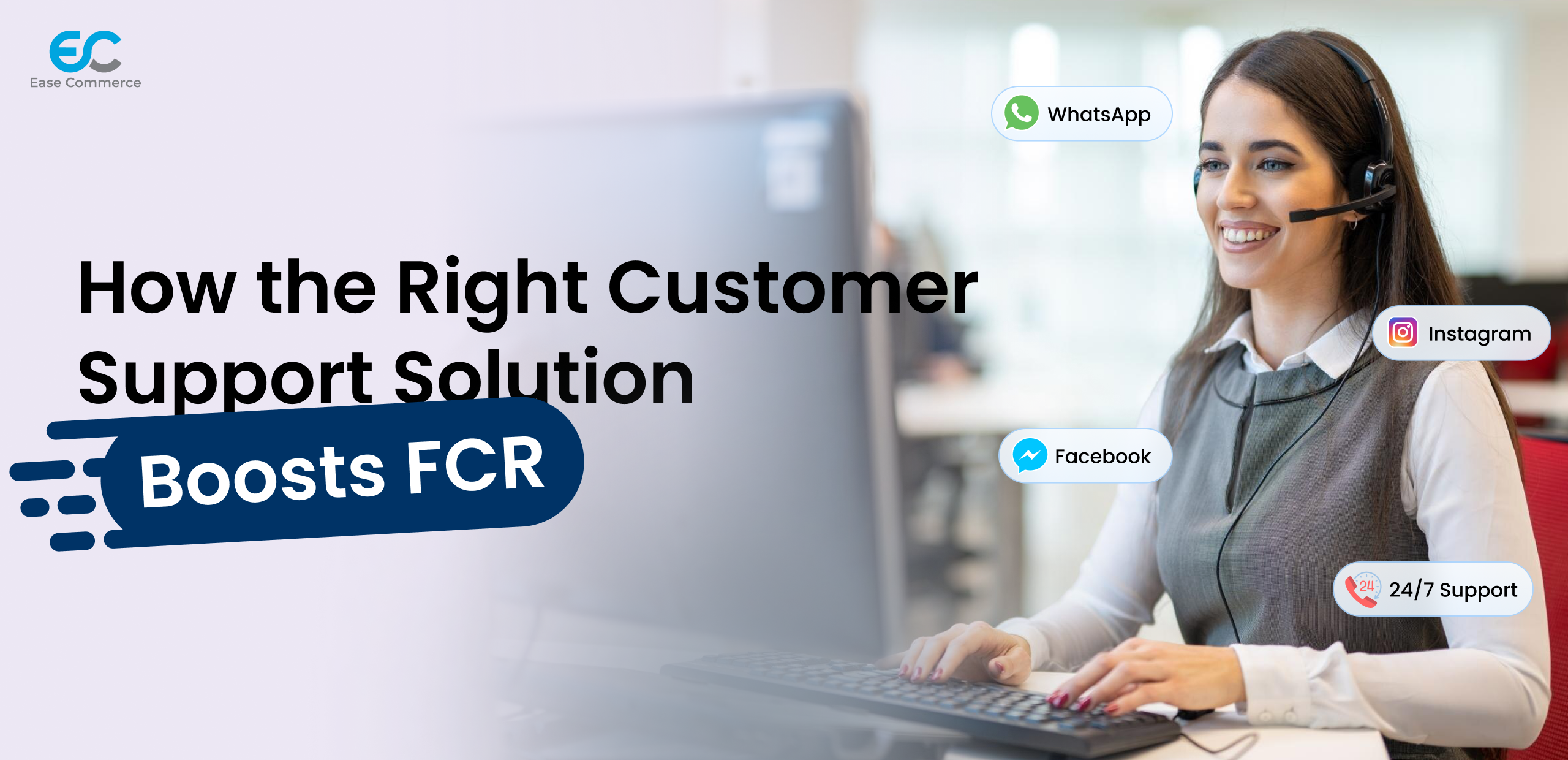
Table of Contents
Featured Posts
- Ease Commerce Becomes India’s Official Amazon MCF Partner: Faster Fulfillment, Zero Chaos
- How the Right Customer Support Solution Boosts FCR
- What Is Returns Management for Multi-Channel Sellers
- Choosing the Right Task Management Software for Sellers
- How to Tell If Your E-Commerce Business Is Ready for a Warehouse Management System
First-Call Resolution (FCR) is exactly what it sounds like: fixing a customer’s problem in the very first interaction. In e-commerce, that single moment can make or break loyalty. If you solve it, the buyer comes back; if you don’t, they churn or flood your support queue with repeat requests.
Right now, most businesses hover around 70–79% FCR, meaning nearly one in four customers still has to contact support again for the same issue. That translates into extra tickets, overworked agents, and customers who are twice as likely to leave a negative review. Research from SQM backs up the stakes: every 1% improvement in FCR increases customer satisfaction by 1% and cuts operating costs by 1%.
Put it in perspective. Imagine a marketplace brand handling 6,000 queries during the festive season. With a 72% FCR, 1,680 issues spill over into repeat contacts. Lift FCR just six points to 78%, and you’ve eliminated 360 repeat tickets that week, basically the workload of a full agent. That’s real payroll saved and real customers kept happy.
Customers feel the difference, too. Studies show satisfaction drops sharply once a problem drags into a second or third contact(nextiva.com). You’ve probably seen it yourself: the tone turns negative, refund requests spike, and retention risk climbs. But when you get it right the first time, the entire interaction feels lighter, shorter, calmer, and more trustworthy.
For CTOs and CEOs, that’s why FCR is a lever for cost efficiency, retention, and growth. And the right customer support solution, one that combines omnichannel data, automation, and CRM intelligence, can push FCR into the 80s, as several AI-enabled case studies have already shown (Source:datamatics.com) (insight7.io)
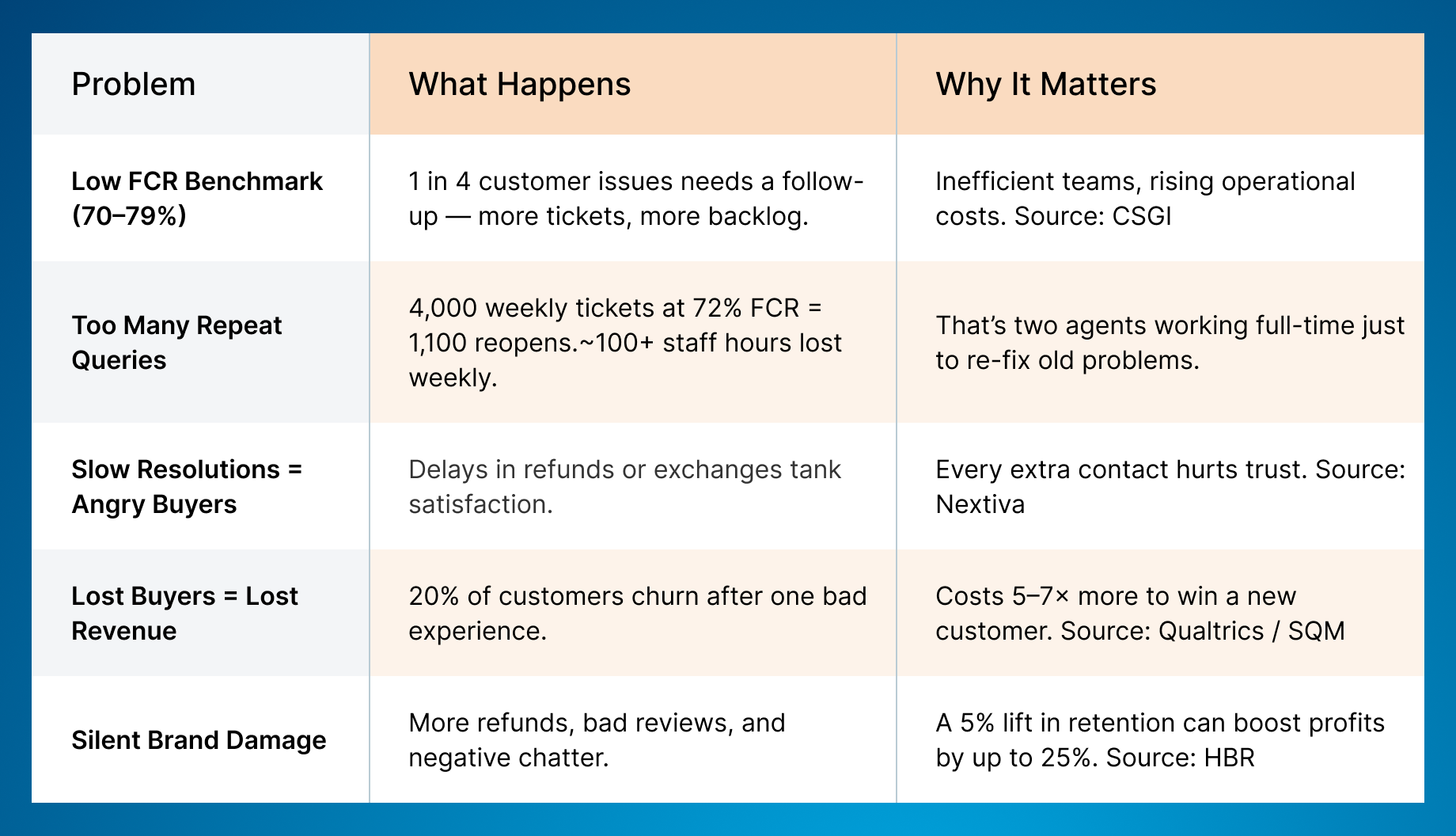
What a Modern Customer Support Solution Does Differently
1. One Dashboard, Zero Fragmentation
Customers don’t care which door they used; it may be WhatsApp, Instagram DMs, email, or marketplace chat; they just want the same conversation, continued. If your team is hopping between tabs and copying IDs from one tool into another, you’re burning time and trust.
Most sellers still operate in silos. WhatsApp for quick chats, Gmail for escalations, marketplace DMs for order complaints, and maybe a spreadsheet to track it all. That setup makes it impossible to maintain continuity. A buyer who complains about a delayed order on Instagram might have already emailed about it, but if your systems don’t talk, your agents repeat questions, customers repeat frustrations, and resolution time doubles.
A modern customer support platform consolidates every channel into a unified omnichannel hub. The agent sees the full conversation history, across social, chat, and email, alongside order, payment, and delivery data. Aberdeen found that businesses with strong omnichannel customer support strategies retain 89% of customers, compared to just 33% for those without it. The math is simple: fewer blind spots mean faster, more confident resolutions.
Ease Commerce takes this principle and makes it practical. Its unified dashboard merges queries from WhatsApp, Facebook, and Instagram, automatically linking them to specific orders or tickets. No duplicate cases. No lost messages.
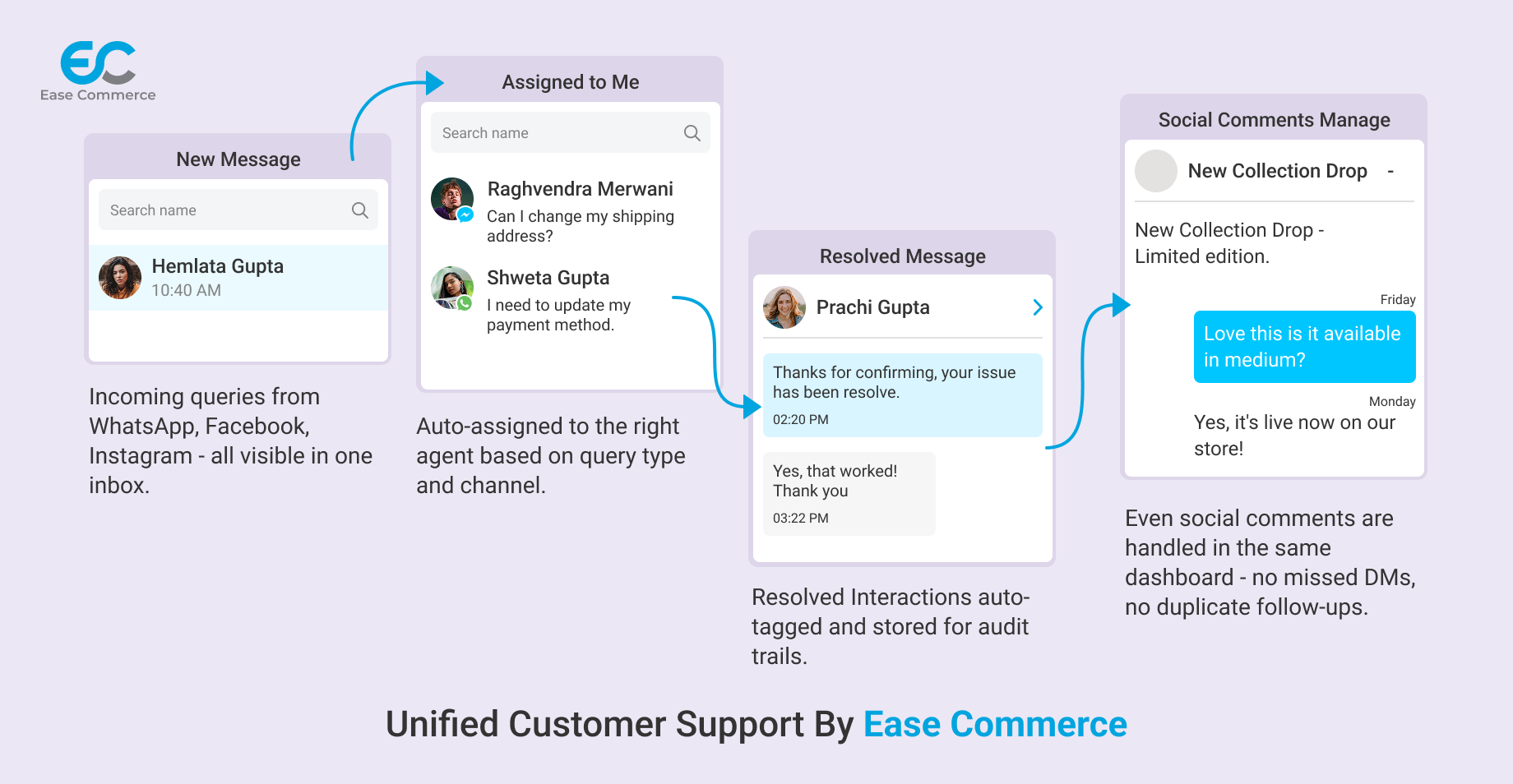
2. Automation That Handles What Humans Shouldn’t
Roughly 60–70% of support queries fall into predictable patterns: “Where’s my order?”, “When will my refund arrive?”, “Is this item returnable?” Those are solvable without human intervention. The right support solution uses AI chatbots and automated workflows to answer these instantly, escalate only when necessary, and hand off context seamlessly to a live agent.
Ease Commerce’s automation tools are built precisely for this. Routine requests are deflected before they hit an inbox, while escalations arrive pre-filled with order data and prior chat history. That’s why brands using similar automation frameworks report up to 43% lower agent handling time and consistently higher FCR. The best part: customers don’t feel they’re talking to a bot, they just get answers faster.
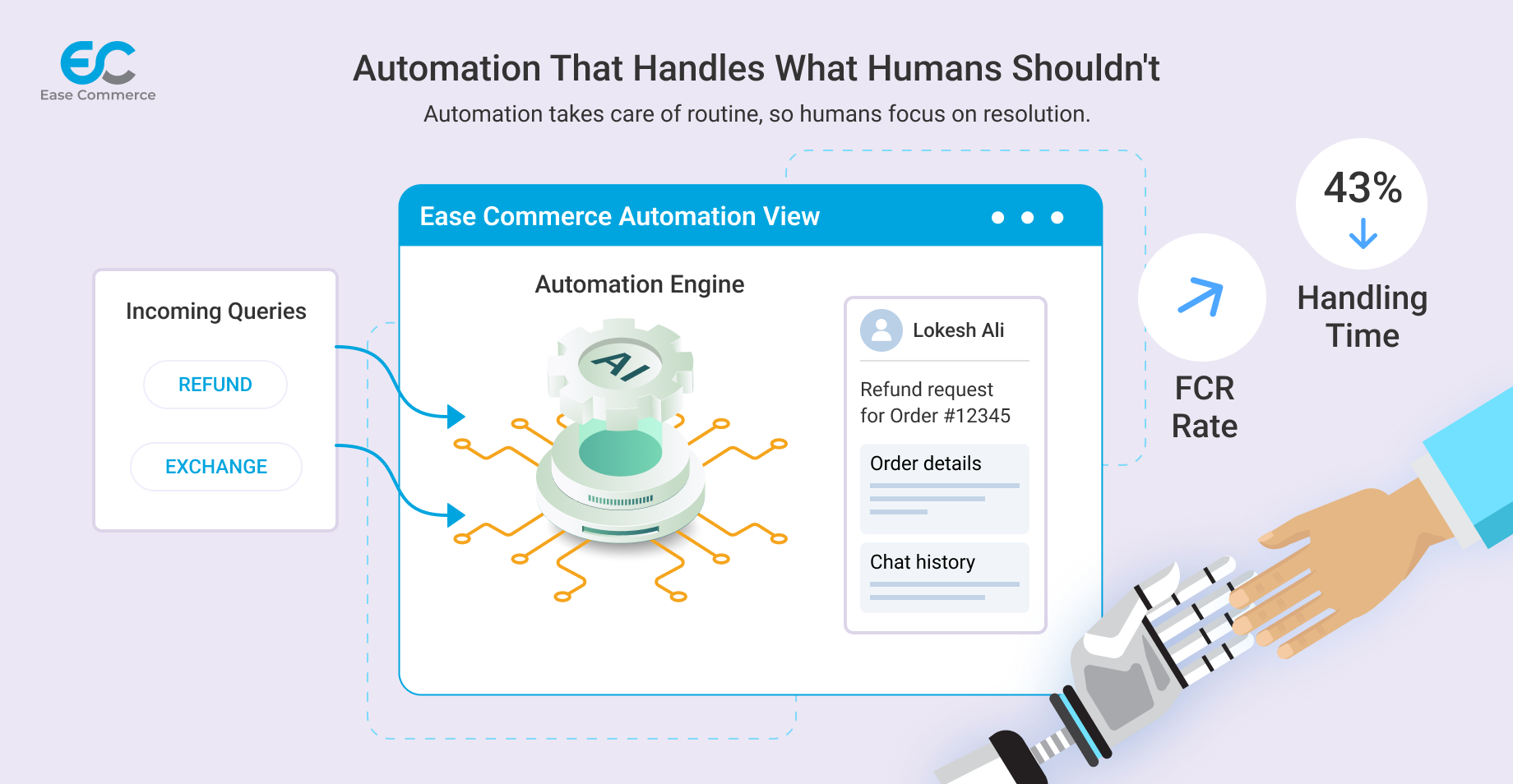
3. Context That Drives Precision
First-call resolution depends less on speed and more on accuracy. An agent who can see the full customer journey in a CRM for customer support, like purchases, returns, complaints, sentiment, solves problems better. Modern systems turn support into a data-driven function with CRM-powered insights, real-time dashboards, and predictive analytics.
McKinsey’s research found that businesses using advanced analytics in support see 10–15% higher CSAT and 20–40% lower operational costs. Ease Commerce fits that model: its platform captures user behavior, tracks interaction trends, and flags anomalies like repeated refund requests or delayed shipments, so teams can intervene before the next ticket even arrives.
4. Summaries That Save Minutes (and Mistakes)
When support teams scroll through five-email threads or long chat logs just to understand what happened, every issue takes longer than it should. The right platform fixes this with automated issue summaries, clear, concise snapshots like: “Order #4567 → delayed courier scan → refund initiated.”
Ease Commerce bakes this intelligence directly into its automated customer support CRM. Agents log in, glance at the summary, and act. That simple workflow shift cuts resolution times and eliminates guesswork, both of which directly boost FCR.
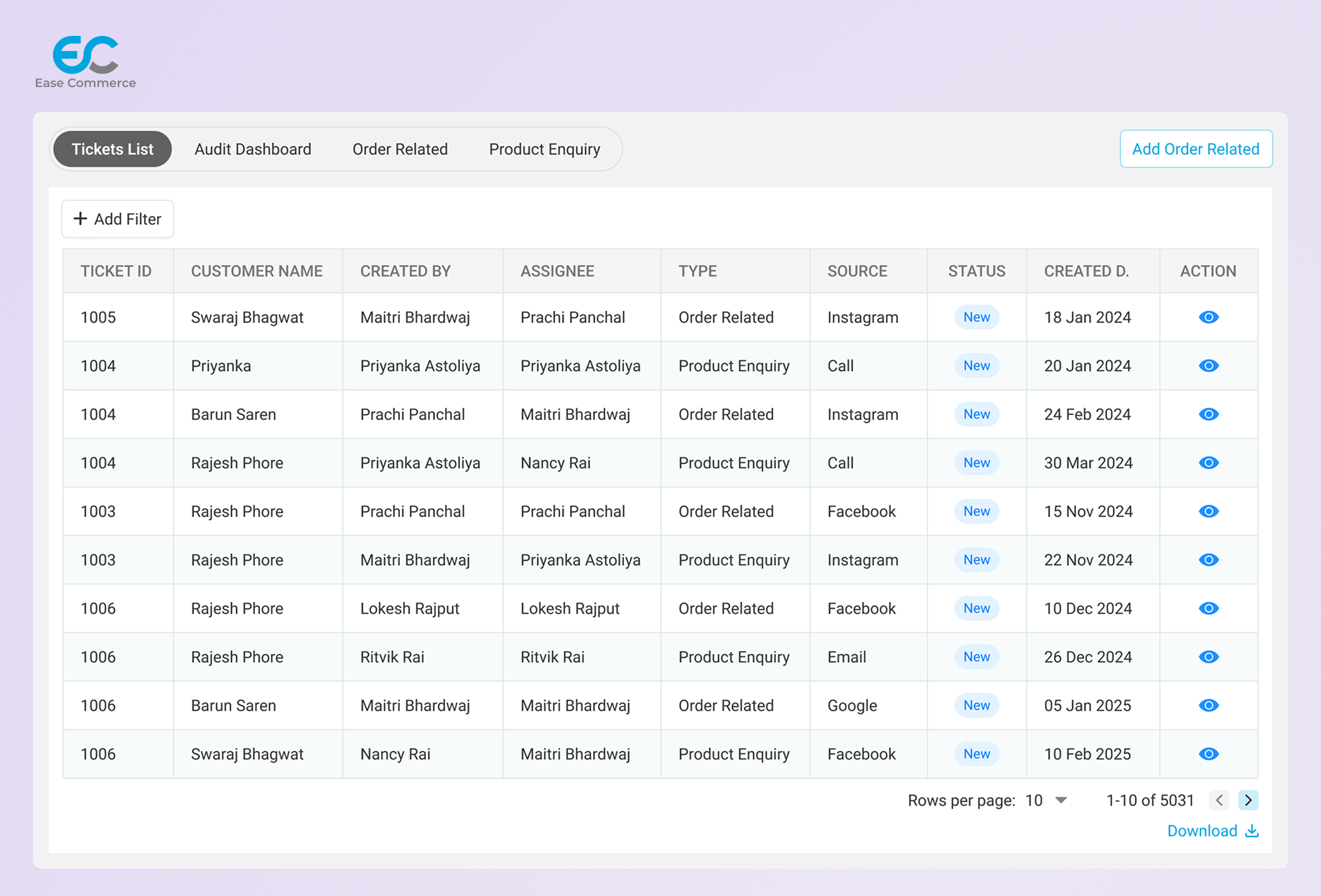
Final Take
Let’s strip it down to what really happens on the floor. A customer who has to reach out twice doesn’t just cost you a few extra minutes; they cost you momentum. Every unresolved chat adds another layer of frustration, and in e-commerce, that friction scales faster than sales do.
The truth is, FCR doesn’t improve because your team suddenly works harder; it improves because your systems stop working against them. When agents have instant visibility into order, refund, and payment data, they don’t need to “check with another department.” When workflows trigger automatically, customers don’t sit in limbo waiting for an update that the system could have sent on its own.
Ease Commerce gets along perfectly with the entirety of your existing systems. It syncs across the messy middle of operations: warehouse, returns, payments, and support. So when a customer complains about a missing product, the system doesn’t just log it; it cross-checks inventory, pulls shipment status, and pushes a proactive message before escalation even happens. That’s how first-contact resolutions stop being luck and start being a process.
And there’s a psychological side people overlook. When customers don’t need to chase updates, they start to trust your timelines again. When agents can see the full journey in one window, they respond with authority instead of apology. That shift from reactive to confident is where customer experience actually changes.
Here’s what that means in plain terms: fewer back-and-forths, faster refunds, less stress during peak weeks, and a support team that’s not drowning in déjà vu.
Ease Commerce Customer Support Software with CRM overcomes the phrase overpromise and makes good service consistent. And in e-commerce, consistency is the currency that keeps customers coming back long after discounts stop working.
👉 Request a Demo to see how leading e-commerce brands are improving first-call resolution and response efficiency with Ease Commerce.
Or explore Ease Commerce Pricing, Alternatives & More (2025) to compare plans, integrations, and user reviews before you decide.
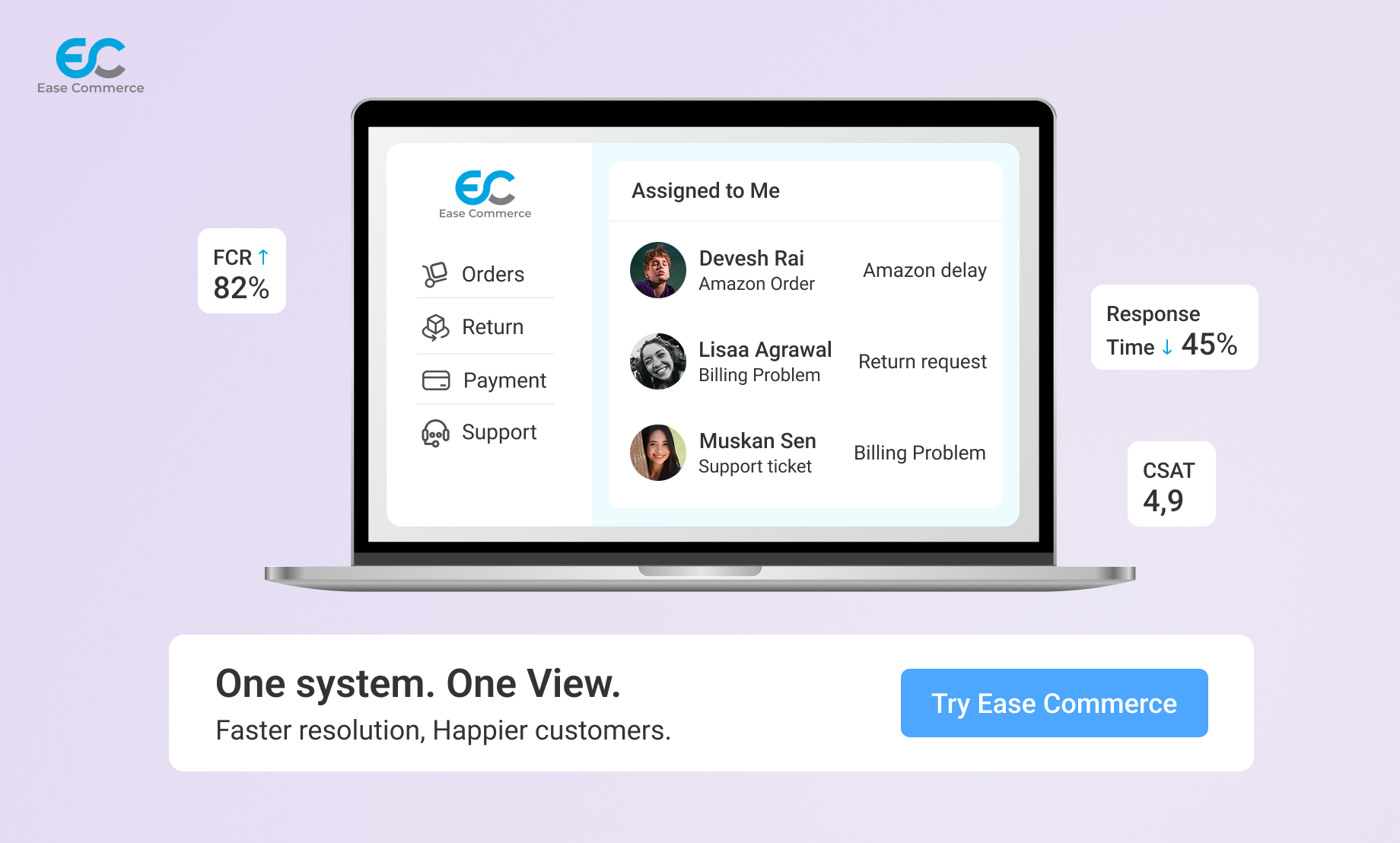
FAQs on Customer Support Solution and FCR
1. What is a customer support solution, and how does it improve First-Call Resolution (FCR)?
A customer support solution centralizes all customer interactions—emails, chats, marketplace queries, and social messages into one platform. This visibility helps agents resolve issues in a single interaction instead of passing tickets between teams. When powered by automation and CRM insights, FCR improves because every customer inquiry gets complete context and faster resolution.
2. How does a CRM for customer support make agents more efficient?
A CRM for customer support gives agents instant access to a customer’s entire journey: orders, payments, refunds, and previous conversations. This eliminates guesswork and repetitive questioning. Integrated CRM data also helps teams personalize responses and automate repetitive workflows, cutting average handling time and boosting customer satisfaction.
3. Can customer support software with CRM automate refund and order tracking processes?
Yes. Modern customer support software with CRM automates high-volume tasks like refund confirmations, order status updates, and delivery follow-ups. Ease Commerce integrates directly with your marketplaces and warehouses to provide real-time order data, so customers get instant answers while agents focus on exceptions, not repetition.
4. How do you calculate your first-call resolution rate?
The formula is simple: FCR = (Issues resolved on first contact ÷ Total support interactions) × 100. For example, if your team resolves 750 out of 1,000 tickets in one touchpoint, your FCR is 75%. A modern customer support platform or customer support software with CRM, like Ease Commerce, tracks this automatically by analyzing chat logs, emails, and order history — eliminating manual effort.
5. What are the main benefits of a high FCR rate?
A strong FCR rate is a direct reflection of efficiency and customer satisfaction. Brands that improve FCR typically see:
- Lower repeat contact rates and reduced ticket volume.
- Faster resolutions that lower operational costs.
- Higher loyalty, customers who get quick answers are 2× more likely to reorder. SQM research confirms: every 1% increase in FCR raises customer satisfaction metrics by 1% and reduces costs by 1%.
6. How can businesses improve their FCR score?
Improving FCR starts with CRM for customer support. When agents can see a customer’s order, refund, and chat history in one view, they make faster, more accurate decisions. Pair that with automation and AI chatbots that handle repetitive “Where’s my order?” queries and you’ve freed agents to focus on complex cases that actually require human touch.
7. What is the difference between FCR and first-contact resolution?
While they sound similar, there’s a subtle difference:
- First-Call Resolution (FCR): Resolving an issue during the first voice or live chat interaction.
- First-Contact Resolution (FConR): Achieving the same goal across any channel, WhatsApp, email, or social DMs. A unified customer support solution like Ease Commerce tracks both in one CRM dashboard, giving a complete view of agent performance.
8. How does FCR affect customer satisfaction and loyalty?
Customers want speed and clarity. When issues are solved in one interaction, it builds trust and encourages repeat purchases. In fact, a high FCR correlates strongly with higher CSAT (Customer Satisfaction) and NPS (Net Promoter Score). With Ease Commerce’s unified customer support software with CRM, brands reduce follow-ups, improve response times, and sustain customer loyalty long-term.